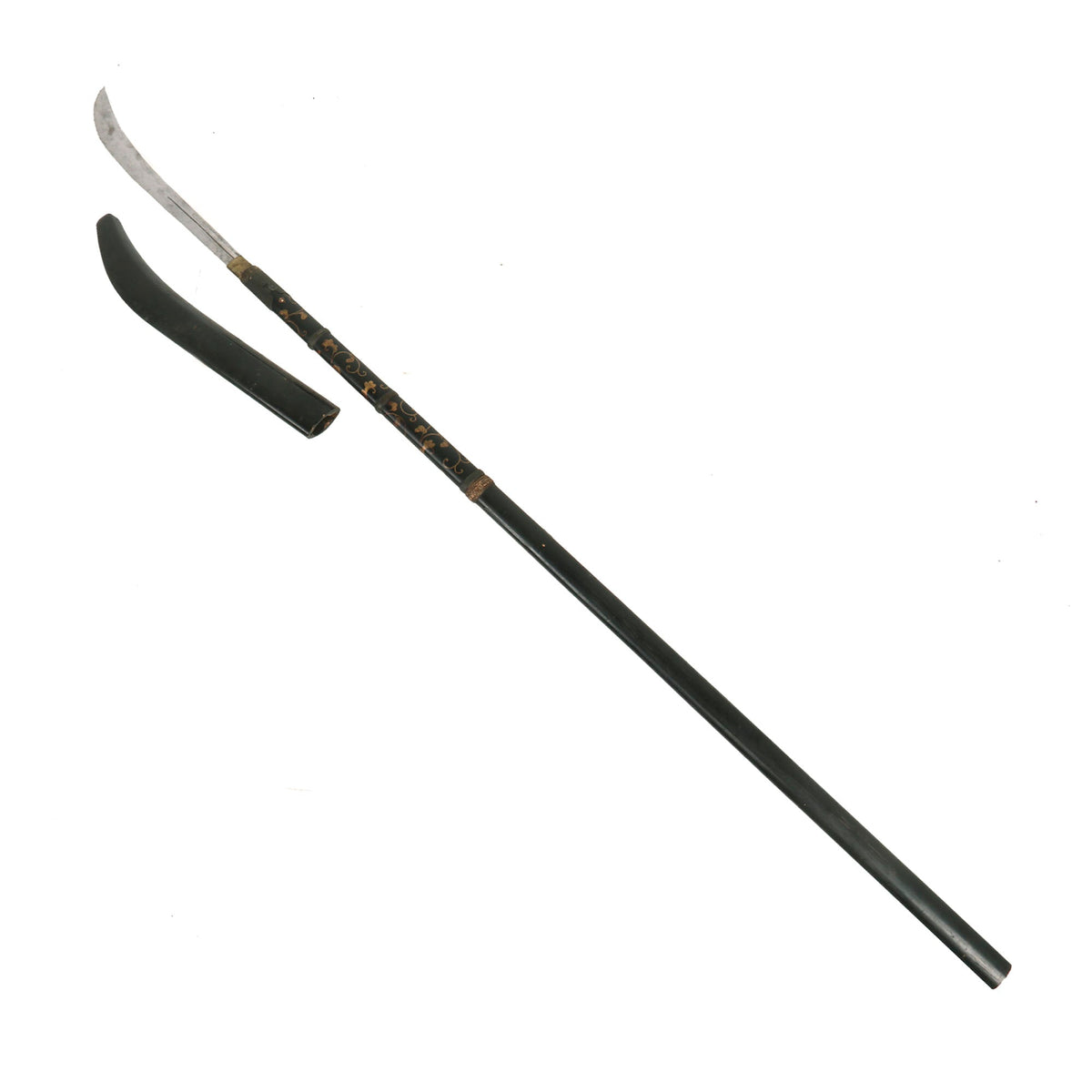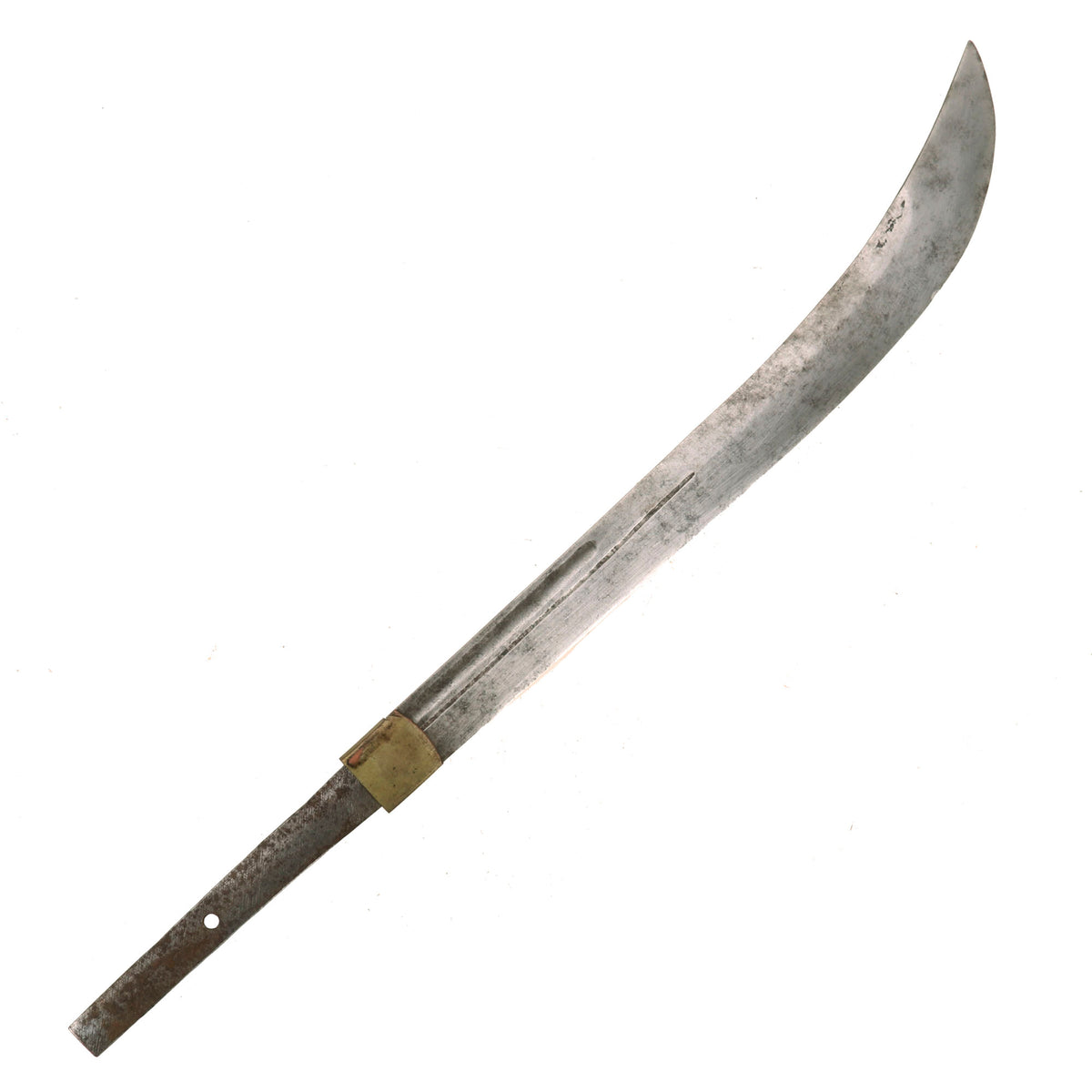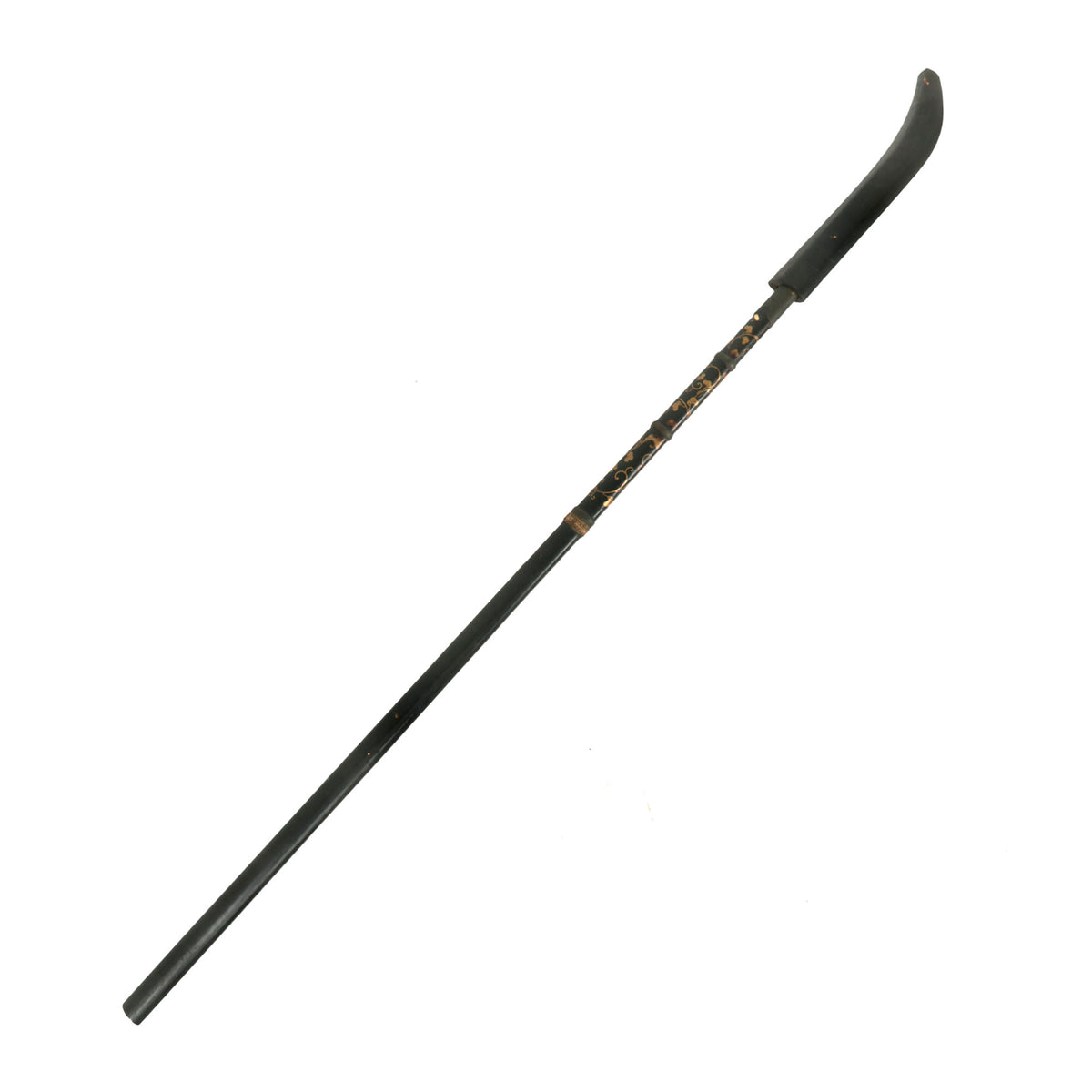Original 18th Century Edo Period Japanese Naginata Polearm with Handmade Blade and Scabbard – 61 Inches Long Original Items
$ 1.295,00 $ 323,75
Original Item: Only One Available. The naginata (なぎなた, 薙刀) is a pole weapon and one of several varieties of traditionally made Japanese blades (nihontō). Naginata were originally used by the samurai class of feudal Japan, as well as by ashigaru (foot soldiers) and sōhei (warrior monks). The naginata is the iconic weapon of the onna-bugeisha, a type of female warrior belonging to the Japanese nobility. Naginata for fighting men and warrior monks were ō-naginata. The kind used by women was called ko-naginata.
This example dates from the mid Edo period (江戸時代, Edo jidai) or Tokugawa period (徳川時代, Tokugawa jidai) of Japanese history. This is the period between 1603 and 1867, when Japan was under the rule of the Tokugawa shogunate and the country’s 300 regional daimyo. The naginata measures 61” in overall length with an 46 1/2” long shaft (Ebu), which definitely had the end sawn off, so it was most likely at least 2 feet longer originally. It was almost certainly used for castle defense or use in the field against soldiers on horseback. It has a typical design wooden saya (scabbard).
The blade has the following period correct features:
– Folded steel blade (fold lines are evident on the spine and body of the blade)
– hole in the tang is punched and not drilled
– Blade wounds (kizu) or lamination artifacts are present on the blade. Both ware (lamination lines) and fukure (carbon pits) are visible.
The Blade of this example is 13 5/8″ long, from the tip (kissaki) to the back notch (mune-machi), and the overall length including the tang is 19 1/4“. The tang is unsigned 無名 (mumei), or “anonymous”. The blade has unfortunately saw much use and cleaning since the last polish, so the hamon is not visible. There are however lamination lines and some carbon pits present, which are definitive for a traditionally laminated blade.
The blade surface has light overall staining staining, with a bit of past staining, but no real pitting or other damage. The edge definitely does show use and wear, with several dents on the edge where it curves. It has a double bo’hi (fuller), which would often be highlighted with red urushi lacquer, however these were either never painted, or have lost the lacquer. The blade has a Futsu 普通 (regular) Nakago (tang) with Kiri (cut) nakago-jiri (tang tip).
The fittings of the naginata are fairly typical, with a long pole (ebu) that has three semegane (rings) around it to help hold it two of which are loose. It has a very nice brass end fitting (fuchi) that surrounds the end of the pole, which has a heart-shaped inlet, a common design used. There is a plated copper habaki around the end of the blade, with no crossguard or seppa. There is a single pin (mekugi), though it is definitely a replacement. The ebu has a lovely black urushi lacquer finish, which is very well retained, and there are some lovely gold floral designs.
The saya (Scabbard) is of the typical style, finished with black urushi lacquer, and measures about 17” x 2 1/2“ at widest. There is light overall wear, as well as some chipping, but no cracking or structural issues. Really a nice scabbard.
A nice early 18th century Japanese Naginata Polearm, ready to display!
Specifications:
Blade Length: 19 1/4“ Overall
Edge Length: 13 5/8″
Tang Length: 5 5/8″
Overall length: 61″ (5 ft 1 in.)
Pole Length: 46 1/2″
Scabbard Dimensions: 17” x 2 1/2”
It has been over one thousand years ago that the art of making swords appeared in Japan. The swordsmiths of the time may not have known it but they were creating a legendary sword. The Samurai sword has seen combat in many battlefields. From the early days of the Samurai warrior to the fierce battles in the South Pacific during WWII.
Each hand-made Japanese blade (日本刀 – Nihonto) is unique because it is forged from multiple pieces of folded steel stock. A tremendous amount of work is dedicated to creating these pieces. They were an instrument of war as much as a beautiful artifact to adorn a room.
The traditional Japanese blade and mountings have grown to be one of the most highly desired military antiques.
Fast Shipping with Professional Packaging
Thanks to our longstanding association with UPS FedEx DHL, and other major international carriers, we are able to provide a range of shipping options. Our warehouse staff is expertly trained and will wrap your products according to our exact and precise specifications. Prior to shipping, your goods will be thoroughly examined and securely secured. We ship to thousands clients each day across multiple countries. This shows how we're dedicated to be the largest retailer on the internet. Warehouses and distribution centres can be located throughout Europe as well as the USA.
Note: Orders with more than one item will be assigned a processing date depending on the item.
Before shipping before shipping, we'll conduct a thorough inspection of the items you have ordered. Today, the majority of orders will be delivered within 48 hours. The delivery time will be between 3-7 days.
Returns
The stock is dynamic and we cannot completely manage it because multiple stakeholders are involved, including our factory and warehouse. So the actual stock may alter at any time. It's possible that you may not receive your order once the order has been made.
Our policy is valid for a period of 30 days. If you don't receive the product within 30 days, we are not able to issue a refund or an exchange.
You can only return an item if it is unused and in the same state as the day you received it. You must have the item in its original packaging.
Related products
Uncategorized
Uncategorized
Uncategorized
Uncategorized
Uncategorized
Uncategorized
Uncategorized
Uncategorized
Australian WWII Owen MK1 Machine Carbine SMG Custom Fabricated Replica with Sling Original Items
Uncategorized
Armored Burgonet Helmet & Polearm from Scottish Castle Leith Hall Circa 1700 Original Items
Uncategorized
Uncategorized
Uncategorized
Uncategorized
Uncategorized
Angolan Rebel 1970s era 60mm Inert Display Mortar from Angolan Civil War Original Items
Uncategorized
Uncategorized
Band of Brothers ORIGINAL GERMAN WWII Le. F.H. 18 10.5cm ARTILLERY PIECE Original Items













































































